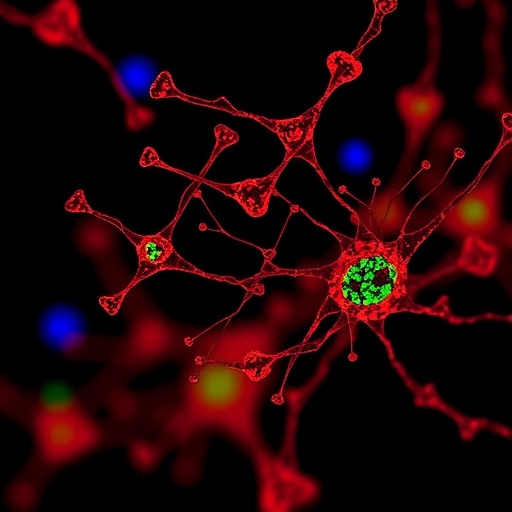In the relentless pursuit of more effective treatments for acute myeloid leukemia (AML), a malignancy notorious for its aggressive nature and poor prognosis, researchers have uncovered a promising therapeutic synergy that could redefine clinical approaches. AML, driven in many cases by mutations in the FLT3 gene, particularly the internal tandem duplication (ITD) variant, has long challenged oncologists with limited response rates and inevitable resistance to monotherapy. However, a pioneering study led by Muyey, Wang, Li, and colleagues introduces a compelling strategy that combines second-generation FLT3 inhibitors with the ERK1/2 inhibitor Ulixertinib, depicting a potent anti-leukemic effect in FLT3-ITD-mutated AML cells.
The study delves into the molecular underpinnings of FLT3-ITD mutations, which result in constitutive activation of the FLT3 receptor tyrosine kinase. This aberrant signaling cascade fuels uncontrolled proliferation and survival of leukemic blasts, making FLT3 a prime target for pharmacological intervention. First-generation inhibitors showed promise but were plagued by resistance mechanisms and off-target effects. The advent of second-generation FLT3 inhibitors marked a significant improvement, offering enhanced specificity and efficacy, yet monotherapy limitations persisted.
The investigators hypothesized that concomitant targeting of downstream signaling pathways could overcome these limitations. Specifically, they focused on the MAPK/ERK pathway, which is intimately involved in cell cycle progression and survival downstream of FLT3 activation. Ulixertinib, a selective ERK1/2 inhibitor, presents a unique mechanism of action by disrupting the phosphorylation events critical for ERK-mediated oncogenic signaling. This approach aims to dismantle the survival network at multiple nodes, preempting adaptive resistance.
In vitro experiments demonstrated that combining second-generation FLT3 inhibitors with Ulixertinib resulted in a significant, synergistic reduction in cell viability among FLT3-ITD-positive AML cell lines. This synergy surpassed the effects observed with either agent alone, indicating a compounding impact on leukemic cell survival. The combination induced profound apoptosis, as evidenced by increased caspase activation and PARP cleavage, underscoring the mechanistic basis of enhanced cell death.
Further mechanistic investigations revealed that the dual inhibition effectively suppressed downstream signaling, notably reducing phosphorylation levels of ERK1/2 and other key effectors in the MAPK pathway. Additionally, the treatment induced cell cycle arrest, particularly at the G1 phase, which effectively halted the proliferative capacity of AML blasts. Such findings suggest that blocking compensatory signaling pathways can buffer against resistance mechanisms that usually impair monotherapy efficacy.
Importantly, the study also assessed the specificity of this combination therapy, demonstrating minimal cytotoxic effects on normal hematopoietic progenitor cells. This selective toxicity profile, critical for clinical applicability, highlights the therapeutic window wherein malignant cells can be targeted while sparing normal tissues. The potential to minimize adverse effects addresses one of the primary limitations of conventional chemotherapies.
The research incorporated state-of-the-art genomic and proteomic analyses to confirm the molecular impacts of treatment. Transcriptomic profiling post-treatment showed downregulation of proliferative and survival gene signatures commonly upregulated by FLT3-ITD activity. Proteomic data corroborated these results, revealing diminished expression and activity of multiple oncogenic mediators associated with AML pathogenesis. These omics approaches offer robust validation and expand understanding of the complex signaling milieu targeted by the drug combination.
From a translational perspective, these findings inform the development of clinical protocols incorporating this combination strategy. Given the aggressive nature of FLT3-ITD-mutated AML and the poor overall survival with standard regimens, integrating Ulixertinib with second-generation FLT3 inhibitors could provide clinicians an advanced therapeutic avenue. Further preclinical studies, including animal models, are warranted to evaluate pharmacodynamics, pharmacokinetics, and long-term efficacy.
This study also opens new vistas for precision oncology, emphasizing that targeting multiple interrelated pathways may be essential for managing genetically complex malignancies. By understanding the molecular circuitry of AML, particularly the interplay between receptor tyrosine kinases and downstream kinases like ERK1/2, researchers can design multi-targeted regimens with the potential to circumvent resistance and relapse.
Moreover, the novel application of Ulixertinib, already under investigation for other solid tumors, to a hematologic malignancy highlights the versatility of ERK inhibitors. This cross-cancer applicability may accelerate regulatory approvals and clinical use, particularly as resistance to kinase inhibitors remains a pervasive challenge in oncology.
The enhanced apoptotic induction observed through this combination treatment also suggests potential synergistic effects if integrated with established chemotherapeutic agents or emerging immunotherapies. Future studies might explore triple combination regimens to further intensify antileukemic responses while monitoring for toxicity and tolerability.
In the broader context of AML research, this work reinforces the critical role of targeted therapies. As broad-spectrum chemotherapeutics give way to molecularly tailored treatments, synergistic combinations that dismantle oncogenic networks at multiple junctures will likely become the standard-of-care. Personalized medicine, guided by genetic profiling of patient tumors, will benefit immensely from such mechanistic insights.
Additionally, the rigorous methodology employed in this study, incorporating functional assays, molecular analysis, and comprehensive validation, underscores the importance of integrative research approaches in oncology drug development. This comprehensive strategy ensures that findings are not just statistically significant but biologically meaningful and applicable.
Excitingly, the translational implications of these findings extend beyond AML. FLT3 mutations, while most prevalent in AML, may also play roles in other malignancies, suggesting that similar synergistic drug combinations could have broader cancer therapeutic relevance.
In summary, the demonstration of synergy between second-generation FLT3 inhibitors and the ERK1/2 inhibitor Ulixertinib marks a pivotal advancement in the fight against FLT3-ITD-mutated AML. By effectively halting survival pathways and inducing apoptosis with selectivity for leukemic cells, this combination opens a promising path toward overcoming therapeutic resistance and improving patient outcomes in one of hematology’s most challenging diseases. The future of AML therapy stands to be transformed by such innovative, rationally designed multi-targeted approaches.
Subject of Research: Therapeutic synergy between second-generation FLT3 inhibitors and ERK1/2 inhibition in FLT3-ITD-mutated acute myeloid leukemia.
Article Title: Synergy Between second-generation FLT3 inhibitors and the ERK1/2 inhibitor Ulixertinib in FLT3-ITD-mutated acute myeloid leukemia (AML) cells.
Article References:
Muyey, D.M., Wang, Y., Li, S. et al. Synergy Between second-generation FLT3 inhibitors and the ERK1/2 inhibitor Ulixertinib in FLT3-ITD-mutated acute myeloid leukemia (AML) cells. Med Oncol 42, 479 (2025). https://doi.org/10.1007/s12032-025-03054-z
Image Credits: AI Generated




